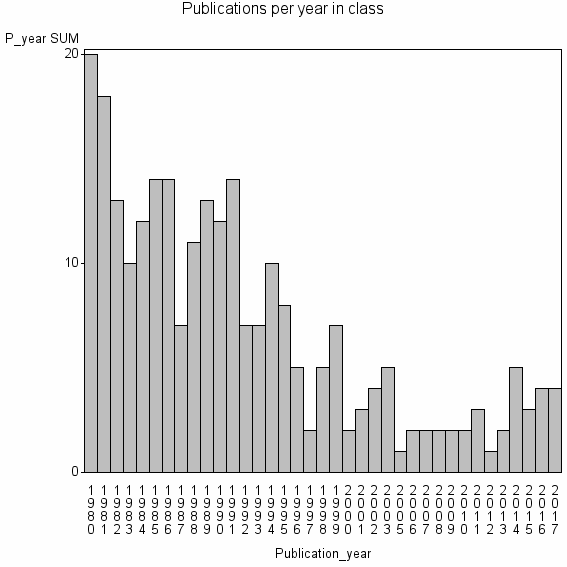
Class information for: |
Basic class information |

Hierarchy of classes |
The table includes all classes above and classes immediately below the current class. |
| Cluster id | Level | Cluster label | #P |
|---|---|---|---|
| 6 | 4 | CHEMISTRY, ORGANIC//CHEMISTRY, INORGANIC & NUCLEAR//CHEMISTRY, MULTIDISCIPLINARY | 1698077 |
| 394 | 3 | CARDIOTOXICITY//ANTHRACYCLINES//SHIKONIN | 32432 |
| 1709 | 2 | SHIKONIN//NAPHTHOQUINONE//PLUMBAGIN | 6976 |
| 27149 | 1 | HRICHTUNG PHARMAZEUT CHEM//1 2 3 4 12 12A HEXAHYDRONAPHTHO2 3 4 5IMIDAZO1 2 APYRAZINE 6 11 DIOL//1 2 3 4 TETRAHYDRO 13 ALKYLPHENYL 3 1 IMINOETHANOBENZOLGQUINOXA LINE 5 10 DIOL DIONE | 256 |
Terms with highest relevance score |
| rank | Category | termType | chi_square | shrOfCwithTerm | shrOfTermInClass | termInClass |
|---|---|---|---|---|---|---|
| 1 | HRICHTUNG PHARMAZEUT CHEM | address | 1223876 | 5% | 76% | 13 |
| 2 | 1 2 3 4 12 12A HEXAHYDRONAPHTHO2 3 4 5IMIDAZO1 2 APYRAZINE 6 11 DIOL | authKW | 123112 | 0% | 100% | 1 |
| 3 | 1 2 3 4 TETRAHYDRO 13 ALKYLPHENYL 3 1 IMINOETHANOBENZOLGQUINOXA LINE 5 10 DIOL DIONE | authKW | 123112 | 0% | 100% | 1 |
| 4 | 2 4 ACETYLPHENYLAMINO 3 PIPERIDINO 1 4 NAPHTHOQUINONE HYDROXYLAMINE HYDRAZINES | authKW | 123112 | 0% | 100% | 1 |
| 5 | 2 5 DIDIMETHYLAMINO 3 6 BROMO P BENZOQUINONE | authKW | 123112 | 0% | 100% | 1 |
| 6 | 2 5 DIDIMETHYLAMINO 3 6 CHLORO P BENZOQUINONE | authKW | 123112 | 0% | 100% | 1 |
| 7 | 2 CHLORO 3 4 N N DIMETHYLAMINOANILINO 1 4 NAPHTHOQUINONE | authKW | 123112 | 0% | 100% | 1 |
| 8 | 2 DIALKYLAMINO 3 AMINOALKYLAMINO 1 4 NAPHTHOQUINONES PHOTOLYSIS | authKW | 123112 | 0% | 100% | 1 |
| 9 | 3 4 DIHYDROBENZOFQUINOXALIN 62H ONES | authKW | 123112 | 0% | 100% | 1 |
| 10 | ACETAMIDE DERIVATIVES | authKW | 123112 | 0% | 100% | 1 |
Web of Science journal categories |
| chi_square_rank | Category | chi_square | shrOfCwithTerm | shrOfTermInClass | termInClass |
|---|---|---|---|---|---|
| 1 | Chemistry, Multidisciplinary | 1875 | 55% | 0% | 140 |
| 2 | Chemistry, Organic | 1163 | 31% | 0% | 79 |
| 3 | Chemistry, Medicinal | 779 | 17% | 0% | 43 |
| 4 | Pharmacology & Pharmacy | 345 | 23% | 0% | 59 |
| 5 | Materials Science, Textiles | 76 | 2% | 0% | 5 |
| 6 | Crystallography | 30 | 4% | 0% | 9 |
| 7 | Chemistry, Applied | 7 | 2% | 0% | 6 |
| 8 | Engineering, Chemical | 6 | 4% | 0% | 9 |
| 9 | Imaging Science & Photographic Technology | 4 | 1% | 0% | 2 |
| 10 | Chemistry, Inorganic & Nuclear | 1 | 2% | 0% | 5 |
Address terms |
| chi_square_rank | term | chi_square | shrOfCwithTerm | shrOfTermInClass | termInClass |
|---|---|---|---|---|---|
| 1 | HRICHTUNG PHARMAZEUT CHEM | 1223876 | 5% | 76% | 13 |
| 2 | FIRST PRINCIPLES SIMULAT GRP | 41036 | 0% | 33% | 1 |
| 3 | PRINCIPLES SIMULAT GRP 1 | 30773 | 1% | 8% | 3 |
| 4 | KURODA CHIROMORPHOL TEAM | 11190 | 0% | 9% | 1 |
| 5 | BIOORGAN CPDS CHEM | 10258 | 0% | 8% | 1 |
| 6 | TECHNOL BIOL ACT SUBST PHARM BIOTECHNOL | 4923 | 0% | 4% | 1 |
| 7 | VOROZHTSOV NOVOSIBIRSK ORGAN CHEM | 4616 | 2% | 1% | 4 |
| 8 | CENT YODOGAWA KU | 4395 | 0% | 4% | 1 |
| 9 | COMPUTAT MAT SCI | 2209 | 2% | 0% | 6 |
| 10 | AD TAT GENET DRUG ISTANCE | 1413 | 0% | 1% | 1 |
Journals |
| chi_square_rank | term | chi_square | shrOfCwithTerm | shrOfTermInClass | termInClass |
|---|---|---|---|---|---|
| 1 | PHARMACEUTICA ACTA HELVETIAE | 14331 | 4% | 1% | 9 |
| 2 | ARCHIV DER PHARMAZIE | 10177 | 7% | 0% | 19 |
| 3 | ZHURNAL ORGANICHESKOI KHIMII | 7138 | 8% | 0% | 21 |
| 4 | ZHURNAL OBSHCHEI KHIMII | 6104 | 8% | 0% | 20 |
| 5 | PHARMAZIE | 6043 | 8% | 0% | 21 |
| 6 | SIBIRSKII KHIMICHESKII ZHURNAL | 3700 | 1% | 1% | 3 |
| 7 | IZVESTIYA SIBIRSKOGO OTDELENIYA AKADEMII NAUK SSSR SERIYA KHIMICHESKIKH NAUK | 2829 | 2% | 0% | 5 |
| 8 | RUSSIAN JOURNAL OF ORGANIC CHEMISTRY | 2595 | 4% | 0% | 11 |
| 9 | KHIMIYA GETEROTSIKLICHESKIKH SOEDINENII | 2342 | 4% | 0% | 11 |
| 10 | BULLETIN OF THE ACADEMY OF SCIENCES OF THE USSR DIVISION OF CHEMICAL SCIENCE | 2029 | 4% | 0% | 9 |
Author Key Words |
Core articles |
The table includes core articles in the class. The following variables is taken into account for the relevance score of an article in a cluster c: (1) Number of references referring to publications in the class. (2) Share of total number of active references referring to publications in the class. (3) Age of the article. New articles get higher score than old articles. (4) Citation rate, normalized to year. |
Classes with closest relation at Level 1 |